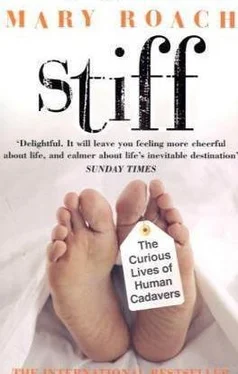Double sentencing wasn’t a new idea, but rather the latest variation on the theme. Before that, a murderer might be hung and then drawn and quartered, wherein horses were tied to his limbs and spurred off in four directions, the resultant “quarters” being impaled on spikes and publicly displayed, as a colorful reminder to the citizenry of the ill-advisedness of crime. Dissection as a sentencing option for murderers was mandated, in 1752 Britain, as an alternative to postmortem gibbeting. Gibbeting—though it hits the ear like a word for happy playground chatter or perhaps, at worst, the cleaning of small game birds— is in fact a ghastly verb. To gibbet is to dip a corpse in tar and suspend it in a flat iron cage (the gibbet) in plain view of townsfolk while it rots and gets pecked apart by crows. A stroll through the square must have been a whole different plate of tamales back then.
In attempting to cope with the shortage of cadavers legally available for dissection, instructors at British and early American anatomy schools backed themselves into some unsavory corners. They became known as the kind of guys to whom you could take your son’s amputated leg and sell it for beer money (37½ cents, to be exact; it happened in Rochester, New York, in 1831). But students weren’t going to pay tuition to learn arm and leg anatomy; the schools had to find whole cadavers or risk losing their students to the anatomy schools of Paris, where the unclaimed corpses of the poor who died at city hospitals could be used for dissection.
Extreme measures ensued. It was not unheard of for an anatomist to tote freshly deceased family members over to the dissecting chamber for a morning before dropping them off at the churchyard. Seventeenth-century surgeon-anatomist William Harvey, famous for discovering the human circulatory system, also deserves fame for being one of few medical men in history so dedicated to his calling that he could dissect his own father and sister.
Harvey did what he did because the alternatives—stealing the corpses of someone else’s loved ones or giving up his research— were unacceptable to him. Modern-day medical students living under Taliban rule faced a similar dilemma, and, on occasion, have made similar choices. In a strict interpretation of Koranic edicts regarding the dignity of the human body, Taliban clerics forbid medical instructors to dissect cadavers or use skeletons— even those of non-Muslims, a practice other Islamic countries often allow—to teach anatomy. In January 2002, New York Times reporter Norimitsu Onishi interviewed a student at Kandahar Medical College who had made the anguishing decision to dig up the bones of his beloved grandmother and share them with his classmates. Another student unearthed the remains of his former neighbor. “Yes, he was a good man,” the student told Onishi. “Naturally I felt bad about taking his skeleton…. I thought that if twenty people could benefit from it, it would be good.”
This sort of reasoned, pained sensitivity was rare in the heyday of British anatomy schools. The far more common tactic was to sneak into a graveyard and dig up someone else’s relative to study. The act became known as body snatching. It was a new crime, distinct from grave-robbing, which involved the pilfering of jewels and heirlooms buried in tombs and crypts of the well-to-do. Being caught in possession of a corpse’s cufflinks was a crime, but being caught with the corpse itself carried no penalty. Before anatomy schools caught on, there were no laws on the books regarding the misappropriation of freshly dead humans.
And why would there be? Up until that point, there had been little reason, short of necrophilia, [4] Which was also, up until 1965, not a crime in any U.S. state. When necrophilia’s best-known modern-day practitioner, Sacramento mortuary worker Karen Greenlee, was caught absconding with a dead young man in 1979, she was fined for illegally driving a hearse but not for the act itself, as California had no statutes regarding sex with the dead. To date, only sixteen states have enacted necrophilia laws. The language used by each state reflects its particular character. While taciturn Minnesota refers to those who “carnally know a dead body,” freewheeling Nevada spells it all out: “It is a felony to engage in cunnilingus, fellatio, or any intrusion of any part of a person’s body, or any object manipulated or inserted by a person into the genital or anal openings of the body of another where the offender performs these acts on the dead body of a human being.”
to undertake such a thing.
Some anatomy instructors mined the timeless affinity of university students for late-night pranks by encouraging their enrollees to raid graveyards and provide bodies for the class. At certain Scottish schools, in the 1700s, the arrangement was more formal: Tuition, writes Ruth Richardson, could be paid in corpses rather than cash.
Other instructors took the dismal deed upon themselves. These were not low-life quacks. They were respectable members of their profession.
Colonial physician Thomas Sewell, who went on to become the personal physician to three U.S. presidents and to found what is now George Washington University Medical School, was convicted in 1818 of digging up the corpse of a young Ipswich, Massachusetts, woman for the purposes of dissection.
And then there were the anatomists who paid someone else to go digging. By 1828, the demands of London’s anatomy schools were such that ten full-time body snatchers and two hundred or so part-timers were kept busy throughout the dissecting “season.” (Anatomy courses were held only between October and May, to avoid the stench and swiftness of summertime decomposition.) According to a House of Commons testimony from that year, one gang of six or seven resurrectionists, as they were often called, dug up 312 bodies. The pay worked out to about $1,000 a year—some five to ten times the earnings of the average unskilled laborer—with summers off.
The job was immoral, and ugly to be sure, but probably less unpleasant than it sounds. The anatomists wanted freshly dead bodies, so the smell wasn’t really a problem. A body snatcher didn’t have to dig up the entire grave, but rather just the top end of it. A crowbar would then be slipped under the coffin lid and wrenched upward, snapping off the top foot or so. The corpse was fished out with a rope around the neck or under the arms, and the dirt, which had been piled on a tarp, would be slid back in.
The whole affair took less than an hour.
Many of the resurrectionists had held posts as gravediggers or assistants in anatomy labs, where they’d come into contact with the gangs and their doings. Drawn to the promise of higher pay and less confining hours, they abandoned legitimate posts to take up the shovel and sack. A few diary entries—transcribed from the anonymously written Diary of a Resurrectionist —yield some insight into the sort of people we’re talking about here:
Tuesday 3rd (November 1811). Went to look out and brought the Shovils from Bartholow,… Butler and me came home intoxsicated.
Tuesday 10th. Intoxsicated all day: at night went out & got 5 Bunhill Row. Jack all most buried.
Friday 27th…. Went to Harps, got 1 large and took it to Jack’s house, Jack, Bill, and Tom not with us, Geting drunk.
It is tempting to believe that the author’s impersonal references to the corpses belie some sense of discomfort with his activities. He does not dwell upon their looks or muse about their sorry fate. He cannot bring himself to refer to the dead as anything other than a size or a gender.
Only occasionally do the bodies merit a noun. (Most often “thing,” as in “Thing bad,” meaning “body decomposed.”) But more likely it was simply the man’s disinclination to sit down and write that accounts for the shorthand. Later entries show he couldn’t even be bothered so spell out “canines,” which appears as “Cns.” (When a “thing bad,” the “Cns” and other teeth were pulled and sold to dentists, for making dentures, [5] How could people of the nineteenth century have allowed teeth from cadavers to be put into their mouths? The same way people from the twenty-first century can allow tissue from cadavers to be injected into their faces to fill wrinkles. They possibly didn’t know and probably didn’t care.
so as to keep the undertaking from being a complete loss.)
Читать дальше












